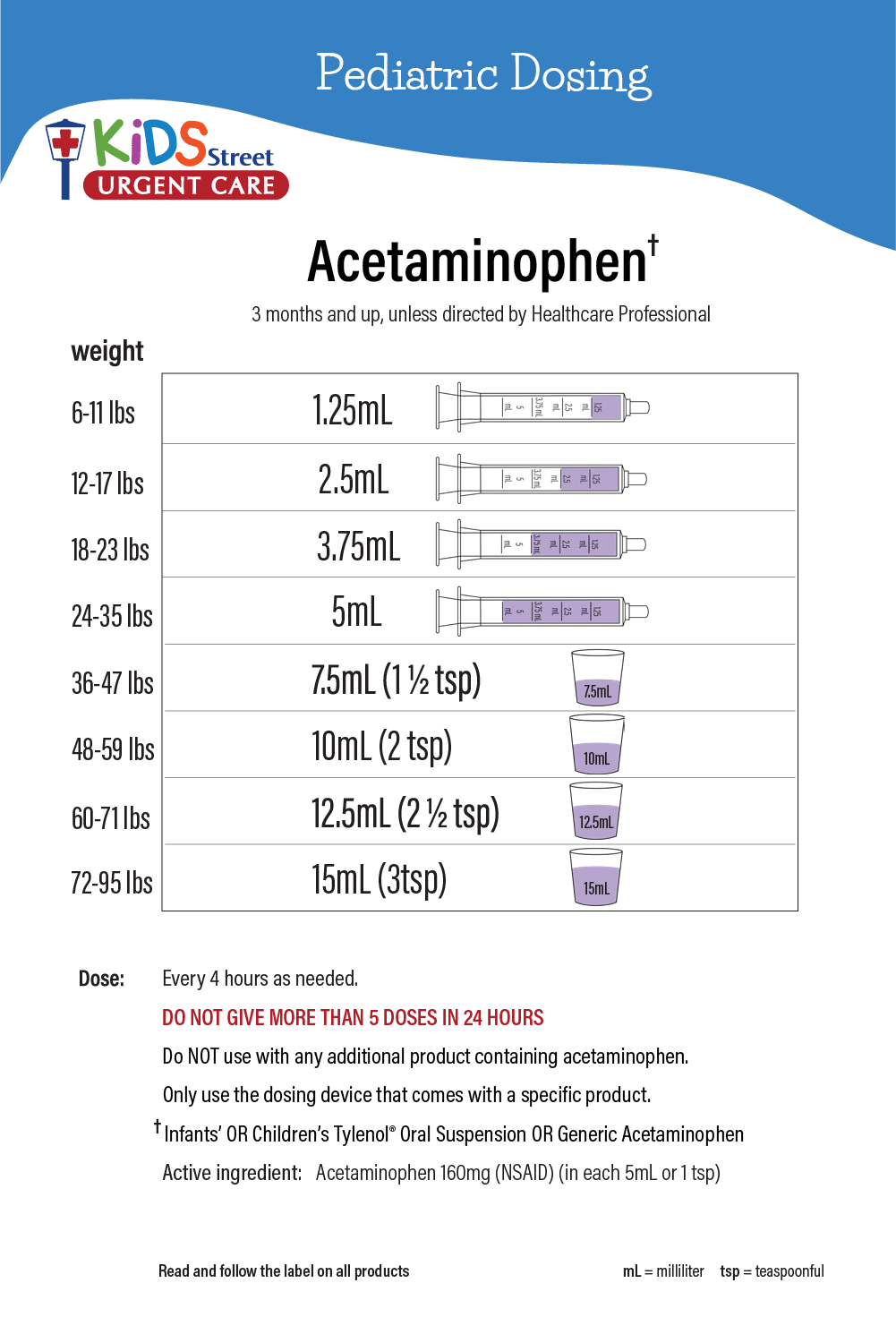Fevers in Kids and other conditions often prompt the questions “how much Tylenol can I give my kid?” and “how often can I give my kid Tylenol?”. Acetaminophen (Tylenol) is a widely-used over-the-counter medicine that effectively reduces fever and relieves pain, making it a staple in many households. Despite its accessibility, it’s crucial to administer it carefully to avoid potential risks, such as liver damage from an overdose. That’s why understanding the proper dosing, reading labels meticulously, and consulting with your pediatrician when uncertain is vital.
Tylenol Dosage For Kids
Acetaminophen dosing depends on the child’s weight and how old they are.
Whether generic or brand name, this medicine contains 160 mg/5ml of its active ingredient, acetaminophen. It should only be administered every 4 hours. Additionally, children should only be given these medications every 4 hours and should not take over five doses in 24 hours.
Giving your child more than the recommended dose of Tylenol can lead to liver damage as the liver processes this medication. This is why it is crucial to always give your kid the correct dose at the proper intervals.

Using Weight-Based Dosing for Accurate Administration
When it comes to giving your child acetaminophen, accuracy in dosing is key. One of the safest ways to ensure you’re administering the right amount is to base the dosage on your child’s weight. This method helps tailor the dose to your child’s specific needs, providing effective relief while mitigating risks.
- Always use the weight-based dosing instructions provided on the medicine label.
- If you’re ever uncertain about the right dosage for your child, consult with your pediatrician to address any concerns and confirm the correct amount.
- Remember to always use a syringe or a dosing tool that comes with the medication for precise measurement, steering clear of household spoons, which may lead to errors and inconsistencies.
Liquid, Chewable, and Other Forms: Choosing the Right Type
When it comes to administering acetaminophen to kids, understanding the different forms available is key to ensuring both effectiveness and safety. You want to find the option that best suits your child’s needs and preferences, whether they’re more comfortable with a liquid solution or can handle a chewable tablet. Let’s explore the choices you have in selecting the right type of acetaminophen for your little one:
- Liquid acetaminophen is a popular choice for younger children under six due to its ease of use, especially when administered using the medicine’s measuring syringe for accuracy. It’s great for those who may have trouble swallowing tablets.
- On the other hand, chewable tablets, available in both 80 mg and 160 mg strengths, offer convenience and ease of use for children aged six and above who might be hesitant about swallowing pills. These options provide an opportunity to choose based on your child’s preferences and specific needs.
Ultimately, the choice between liquid form or chewable tablets depends on the child’s age, weight, and preference. Both options effectively reduce fever and ease pain when used correctly. Always ensure you’re using the appropriate measuring tool and follow dosing instructions carefully to keep your little one safe and comfortable.
For more guidance on acetaminophen and its administration, check out this resource from the Mayo Clinic.
The Importance of Reading Medicine Labels
Reading medicine labels is a crucial step in ensuring your child’s safety when administering acetaminophen. These labels provide valuable information about the correct dosage, concentration, and frequency, helping to prevent overdosing and potential health risks. Before giving any medication, consider the following:
- Carefully review the label.
- Confirm the acetaminophen concentration.
- Check if the medicine is part of a combination product.
This practice not only safeguards against accidental overdoses caused by taking multiple medications with acetaminophen but also reinforces responsible medication habits.
For more guidance on administering acetaminophen safely, visit KidsHealth or consult the Tylenol dosage guide. Trust the label as your guide to providing the right care for your child.
Tips for Talking to Your Pediatrician About Acetaminophen
When talking to your pediatrician about acetaminophen for your child, it’s essential to:
- Jot down any symptoms your child is experiencing, including their frequency and duration.
- Be straightforward about any other medications your child is taking, as these may contain additional acetaminophen.
- Don’t hesitate to ask about the right dosage and form, whether it’s liquid or chewable tablets, especially if your child is under 2 years of age.
- Inquire about potential side effects or signs of an adverse reaction.
- Express any concerns you have about current conditions that might affect acetaminophen use, like allergies or liver issues.
Your pediatrician is there to guide and reassure you, so feel free to ask any questions for clarity and understanding. For more detailed guidance, consider checking this resource.
Turn to KidsStreet Urgent Care
Is your kiddo struggling with a fever that won’t reduce? KidsStreet urgent care services can help them heal and feel better FAST!
Register online to see a healthcare provider at one of our kid-friendly clinics near you. You and your little one can wait in the convenience of your home or car until we’re ready to see you. We’ll text you when it’s time to head to the clinic.
We love walk-ins! However, we do recommend registering online to reduce your in-clinic wait time. Walk-ins join the same queue as those who register online.

